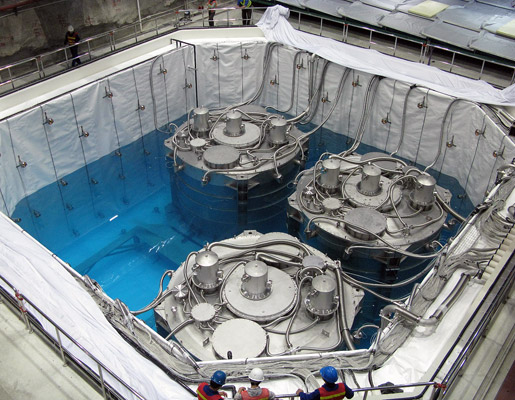Changing flavors
Physicists find key value of neutrino oscillation
An international team of physicists has reported the first set of observations detailing important behavior of neutrino oscillation, an accomplishment that is a necessary step to additional experiments intended to answer fundamental questions about the makeup of the universe.
Physicists operating the Daya Bay neutrino experiment in China have observed a neutrino “mixing angle” known as θ13 (pronounced “theta one-three.”) Robert McKeown says Daya Bay’s discovery of θ13 is the final piece needed to complete the understanding of how these mysterious particles oscillate between three forms, or “flavors,” to another. Neutrinos are byproducts of nuclear reactions, emitted in enormous quantities by the sun, by nuclear activity in the core of the earth and by nuclear power plants. Despite their large numbers, neutrinos are extremely hard to detect.
McKeown, the Governor's Distinguished CEBAF Professor in William & Mary’s physics department as well as deputy director for science at Jefferson Lab, leads the William & Mary contingent working on the Daya Bay experiment. McKeown and his collaborators built a set of instruments designed to observe the stream of particles emitted from a nuclear power facility.
“Neutrino physics is a very important part of particle physics these days,“ McKeown said. “The first thing that knowing this particular mixing angle allows us to do is to confidently mount the next series of experiments that are to be done.”
He said the Daya Bay results give physicists the scientific grounds to proceed with more ambitious neutrino experiments. McKeown has been involved in planning of the Long-Baseline Neutrino Experiment (LBNE), which, when constructed, will send a neutrino beam more than 1,000 kilometers through the earth from Fermilab, in Batavia, Ill., to a detector that will be located outside Lead, S.D.
The LBNE (which has yet to be funded, let alone constructed) and similar experiments seek to use neutrinos to observe a phenomenon known as CP symmetry violation.
“Basically it means that particle reactions and antiparticle reactions are different,” McKeown said. “This is a very important feature that would allow physicists to explain how the universe seems to contain matter, but not antimatter.”
McKeown’s William & Mary group has two important functions at Daya Bay. First, the team had substantial responsibility for the installation, commissioning and calibration of the detection apparatus.
“Since this experiment is so precise, the equipment needs to be calibrated very, very precisely,” McKeown said, adding that Daya Bay has eight detectors and each detector has three units. “Not only are the detectors deep underground, but they’re also underwater. It’s a complicated set of equipment and a complicated set of data that needs to be analyzed.”
The William & Mary team also kept account of the neutrinos detected by the apparatus. Wei Wang, William & Mary research scientist, spent much of his time at Daya Bay site overseeing the installation and calibration of the detector equipment, but McKeown said much of the team’s work can be done here in the United States, working with data sent from the detectors and the reactor plant.
China and the United States lead the Daya Bay Reactor Neutrino Experiment, which includes participants from Russia, the Czech Republic, Hong Kong, and Taiwan. The Chinese effort is led by Yifang Wang of the Institute of High Energy Physics, while leaders of the U.S. effort, in addition to McKeown, include project manager Bill Edwards of Lawrence Berkeley National Laboratory, Steve Kettell of Brookhaven National Laboratory and Karsten Heeger of the University of Wisconsin.
McKeown was interviewed about the discovery for a story in the top journal Science.















